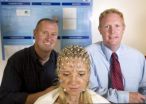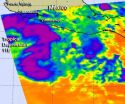(Press-News.org) With homeland security on high alert, screening systems to search for concealed weapons are crucial pieces of equipment. But these systems are often prohibitively expensive, putting them out of reach for public spaces such as train and bus stations, stadiums, or malls, where they could be beneficial.
Now Dr. Eran Socher of Tel Aviv University's Faculty of Engineering is reconfiguring existing complementary metal-oxide-semiconductor (CMOS) chips designed for computers and turning them into high frequency circuits. The ultimate goal is to produce chips with radiation capabilities, able to see through packaging and clothing to produce an image of what may be hidden underneath.
Currently being developed through a collaboration between teams at TAU and Frankfurt University, the chip could be the basis of sophisticated but affordable and portable detection technology able to meet everyday security needs. The research has been published in IEEE Microwave and Wireless Components Letters and will be presented at the International Conference on Infrared, Millimeter, and Terahertz Waves in Australia this September.
Big security benefits on a miniaturized scale
Currently, advanced security technology is massive in size and comes with a massive price tag. Such scanning systems are often developed for selected airports or used by NASA for space exploration, says Dr. Socher. "Our concept is different. For everyday use, security technology needs to be both small and cheap," he explains.
By adding new capabilities to existing CMOS technology, already mass-produced for computers and other mobile devices, the researchers are producing new integrated circuits at an affordable price. The chip, which measures a miniature 0.5 mm by 0.5 mm, newly integrates antennae, giving it the ability to receive and transmit millimeter wave or terahertz radiation. When combined with either mechanical or electronic scanning technology, the resulting radiation can produce an image.
Unlike X-ray technology which penetrates the body, the chip is designed to see only through materials such envelopes, clothing, or luggage, stopping at the human skin. Because the chip works with radiation levels that are lower than those of a cell phone, it circumvents health concerns. And the chip can also produce a more accurate depiction of concealed objects, an advantage over common metal detectors which aren't very specific or sensitive, says Dr. Socher.
Facilitating high-speed transfers
Another application for the chips, which have a range of only a few meters but operate at high frequencies, is high-speed communications. The data rate can range from 1 to ten gigabytes per second, explains Dr. Socher, so the chip could be used to transfer a file — like an uncompressed high-definition video from a mobile device to a screen or projector — wirelessly and within seconds.
Communications and software companies have already expressed an interest in this technology, he says, and the researchers have received a grant from the Broadcom Foundation in the US to support and further their research.
###
American Friends of Tel Aviv University (www.aftau.org) supports Israel's leading, most comprehensive and most sought-after center of higher learning. Independently ranked 94th among the world's top universities for the impact of its research, TAU's innovations and discoveries are cited more often by the global scientific community than all but 10 other universities.
Internationally recognized for the scope and groundbreaking nature of its research and scholarship, Tel Aviv University consistently produces work with profound implications for the future.
END
EVANSTON, Ill. --- When mercury is dumped into rivers and lakes, the toxic heavy metal can end up in the fish we eat and the water we drink. To help protect consumers from the diseases and conditions associated with mercury, researchers at Northwestern University in collaboration with colleagues at Ecole Polytechnique Fédérale de Lausanne (EPFL) in Switzerland, have developed a nanoparticle system that is sensitive enough to detect even the smallest levels of heavy metals in our water and fish.
The research was published September 9 in the journal Nature Materials.
"The ...
Most older adults prefer to maintain their independence and remain in their own homes as they age, and robotic technology can help make this a reality. Robots can assist with a variety of everyday living tasks, but limited research exists on seniors' attitudes toward and acceptance of robots as caregivers and aides. Human factors/ergonomics researchers investigated older adults' willingness to receive robot assistance that allows them to age in place, and will present their findings at the upcoming HFES 56th Annual Meeting in Boston.
Changes that occur with aging can ...
It is commonly assumed that you can "work up an appetite" with a vigorous workout. Turns out that theory may not be completely accurate – at least immediately following exercise.
New research out of BYU shows that 45 minutes of moderate-to-vigorous exercise in the morning actually reduces a person's motivation for food.
Professors James LeCheminant and Michael Larson measured the neural activity of 35 women while they viewed food images, both following a morning of exercise and a morning without exercise. They found their attentional response to the food pictures decreased ...
A paper recently published in the Journal of Animal Science helps researchers further understand how microbials and probiotics affect poultry health.
Researchers at the North Carolina State University and Chung Jen College of Nursing, Health Sciences and Management (Taiwan) conducted a study to investigate the effects of direct fed microbials on energy metabolism in different tissues of broiler chickens. The researchers wanted to learn how consuming microbials and probiotics could change energy use and immune function. Typically, direct fed microbials and probiotics are ...
A new Johns Hopkins study has unraveled the changes in a key cardiac protein that can lead to heart muscle malfunction and precipitate heart failure.
Troponin I, found exclusively in heart muscle, is already used as the gold-standard marker in blood tests to diagnose heart attacks, but the new findings reveal why and how the same protein is also altered in heart failure. Scientists have known for a while that several heart proteins — troponin I is one of them — get "out of tune" in patients with heart failure, but up until now, the precise origin of the "bad notes" remained ...
Abstinence from smoking seems to affect teens differently than adults in a couple ways, but a new study provides evidence that most of the psychological difficulties of quitting are as strong for relatively new, young smokers as they are for adults who have been smoking much longer.
"Adolescents are showing — even relatively early in the dependence process — significant, strong, negative effects just after acute abstinence from smoking," said L. Cinnamon Bidwell, assistant professor (research) in psychiatry and human behavior and the Center for Alcohol and Addiction Studies. ...
Tropical Depression 14 strengthened into Tropical Storm Nadine while NASA's Hurricane Severe Storm Sentinel Mission, or HS3 mission, was in full-swing and NASA's Global Hawk aircraft captured the event. While the Global Hawk was gathering data over the storm, NASA satellites were also analyzing Nadine from space.
NASA's Global Hawk landed back at Wallops Flight Facility, Wallops Island, Va., after spending a full day gathering data from the 14th Atlantic Tropical Depression that strengthened into Tropical Storm Nadine during the morning hours of Sept. 12.
The Global ...
One of NASA's infrared "eyes" is an instrument that flies aboard the Aqua satellite, and it provided data that helped forecasters determine that low pressure "System 90E" strengthened into the eastern Pacific Ocean's eleventh tropical depression.
The Atmospheric Infrared Sounder (AIRS) instrument onboard Aqua captured an infrared image of System 90E on Sept. 11 at 1947 UTC (3:47 p.m. EDT). That infrared image took the temperatures of the cloud tops and found some strong, high thunderstorms wrapped around the western side of the low pressure area's circulation, from north ...
Chevy Chase, MD—Gestational exposure to ambient urban air pollution, especially during late pregnancy, may contribute to lower vitamin D levels in offspring, according to a recent study accepted for publication in The Endocrine Society's Journal of Clinical Endocrinology and Metabolism (JCEM). According to study authors, this could affect the child's risk of developing diseases later in life.
Recent data have demonstrated that maternal vitamin D deficiency during pregnancy may have an influence on the development of asthma and allergic diseases in offspring. A number ...
Chevy Chase, MD—Slow-wave sleep, or 'deep sleep', is intimately involved in the complex control of the onset of puberty, according to a recent study accepted for publication in The Endocrine Society's Journal of Clinical Endocrinology and Metabolism (JCEM).
The many changes that occur in boys and girls during puberty are triggered by changes in the brain. Previous studies have shown that the parts of the brain that control puberty first become active during sleep, but the present study shows that it is deep sleep, rather than sleep in general, that is associated with ...



